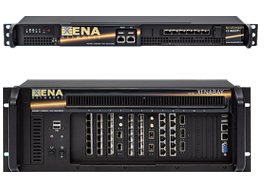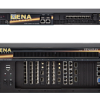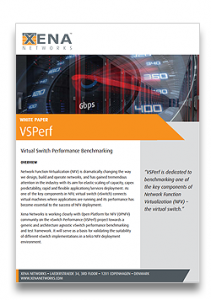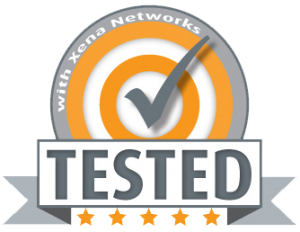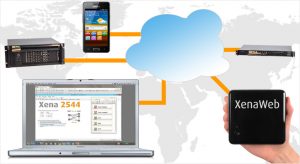Providers of Ethernet-based network devices and services can benefit from the ease-of-use, cost efficiency, interoperability, and scalability of the Xena Networks test platform. In addition, the world’s highest density and lowest power consumption per test port delivers a test platform ready for the future.
Developers and providers of Ethernet-based network appliances and services can deploy the Xena Networks test platform as an ideal complement or alternative to test equipment solutions from Ixia and Spirent, at a price point which obsoletes in-house custom built test solution projects.
The high precision, stream based, wire-speed traffic generation and analysis capabilities are suited for testing of network devices under deliberate error, stress, and random conditions. Packet formats can be defined per individual packet byte, and packet spacing, transmission rates, and bursts can be defined with byte and kbps accuracy.
Network equipment manufacturers and service providers can demonstrate that end user triple play QoE is guaranteed during network congestion, by generating traffic loads representing tens of thousands of individual network users.
A free Windows GUI client (XenaManager-2G) is provided for ad-hoc test execution, and remote management of test equipment located in multiple locations, as well as GUI clients for automated RFC 2544, Y.1564, RFC 2889 and RFC 3918 testing. Finally, an open TCP/IP based text API lets users automate testing from any software environment, using Tcl, Python, Perl, VBA and Java wrappers to convert to/from the generic Xena Command Line Interface (CLI) format.
The Xena test platform provides a complete suite of copper and optical Gigabit Ethernet and 10/40/100-Gigabit Ethernet modules. The 10/40/100-GigE interfaces include optical SFP+, XFP, SR4, LR4, QSFP+, RJ45+ and SR10. The GigE interfaces include copper 10/100/1000M Ethernet and optical 100/1000M Ethernet.
One XenaBay can hold up to:
- 6 x 100-GigE (LR4 / SR10)
- 6 (LR4) / 12 (SR4) / 24 (QSFP+) x 40-GigE
- 144 x 10-GigE copper/optical ports
- 72 x GigE copper/optical ports
|
One XenaCompact can hold up to:
- 1 x 100 GigE (LR4 / SR10)
- 1 (LR4) / 2 (SR4) / 2 (QSFP+) x 40-GigE
- 6 x 10-GigE copper/optical ports
- 6 x GigE copper/optical ports
|
Test components
The Xena test platform provides a flexible and high port count L2-3 test platform that easily interfaces to 3rd party test software including Veryx ATTEST. Clients connect with standard Ethernet GigE interfaces to the test platform, with support for remote access using IP addressing.
Xena’s wire speed test modules are provided in high-density 1U (XenaCompact) and 4U (XenaBay) chassis form factors, with full support for multi-user environments for both interactive GUI and automated script based test sessions.
Stream oriented traffic generation
Users can define and generate hundreds of transmit and receive streams with their own unique traffic profile. Each stream can generate 100k’s of unique traffic flows by using programmable packet field modifiers to increment or randomize field values such as MAC addresses, IP addresses, and VLAN identifiers. This makes it easy to scale your tests beyond the maximum performance parameters of your network or device.
The stream rate can be defined as a percentage of line rate, frames per second, bit-rate, and the injection of packets can be controlled as a single-packet shot, number of packets, time duration, or in continuous mode. Traffic profiles can be defined as uniform or bursty, and custom packet editing is facilitated by a graphically driven field editor that lets users build any packet format, in addition to predefined packet templates for Ethernet, Ethernet II, VLAN, ARP, IPv4, IPv6, UDP, TCP, LLC, SNAP, GTP, ICMP, RTP, RTCP, STP, SCTP, MPLS, PBB, FCoE, IGMPv2/3, or fully specified by user.
Real time analysis and reporting
Packet flow statistics are tracked per stream, or per-user defined filters which can include any combination of programmable field values. Incoming packet streams are automatically identified using optionally auto inserted Test Payload fields. Analysis of traffic throughput, latency, jitter, loss, sequence, and misorder errors is performed real-time per received stream with 16/32 ns accuracy depending on the interface type (optical/electrical).
Users can capture packets at wire speed on each port for detailed analysis and hot-button export packet analysis tool WireShark, which in conjunction with event triggering and programmable filters provides a unique ability to identify and isolate performance issues.
API scripting from any tool environment with XenaScripting
XenaScripting is a free open specification text-based Command Line interface (CLI) API that makes it easy to script for test automation purposes from any tool and scripting environment, only requiring that the scripting environment support text and line-based TCP/IP communication.
Any changes made using XenaScripting are automatically reflected on the GUI. This unique and easy to use scripting-from-anywhere concept lets the user access the Xena test platform from any proprietary or commercial scripting environment based on languages such as Tcl, Python, Perl, VBA, or Java development environments, using wrapper to convert from existing script APIs to the generic Xena API.
As an alternative for GUI and script based test case execution, the user can configure, execute, and log statistics using a standard MS Excel program. The MS Excel templates provided by Xena use VBA to communicate with the test equipment using Xena’s TCP/IP scripting language, and is a very powerful means for operating the equipment for anyone familiar with MS Excel.
Stream and Flow Generation
Transmission Mode
- Interleaved or sequential stream scheduling
- Continuous, or a specified number of packets sent once, between 1 and 4G packets
- Latency measurements across multiple ports with 16/32 ns accuracy depending on interface type (optical/electrical)
Bandwidth distributions
- Constant (100% uniform) and burst distributions
- All loads can be specified in percentage of line rate, frames/s, or Mb/s
- Burst parameters specified by burst length, and burst density
Packet headers
- Completely specified by the user, or Ethernet, Ethernet II, VLAN, ARP, IPv4, IPv6, UDP, TCP, LLC, SNAP, GTP, ICMP, RTP, RTCP, STP, SCTP, MPLS, PBB, FCoE, IGMPv2/3, or fully specified by user
- Any field in a packet template can be set to an invalid value for negative testing
Packet payloads
- An incrementing 8 bit pattern
- PRBS-31
- Autofill with a user-specified pattern
Field modifiers
- Up to five field modifiers can be applied to any field in a packet, per streams. The modifiers can be chained together
- A field modifier can be set to increment or decrement or be random within a specified range. For example, increment VLAN ID, and traversing the IP ToS field in a chained order
Packet length distributions
- Fixed – all frames belonging to the stream are sent with same length
- Incrementing/decrementing – from a specified minimum and maximum length
- Random – randomly selected between a specified minimum and maximum length
- Butterfly – uniform selecting between a specified minimum and maximum length
- MIX – approximates typical traffic on the Internet with packet lengths varying between 56 – 1518 bytes
Test payload
A proprietary test payload can optionally be automatically placed into packets. This allows the test platform to provide per-stream packet loss, min/max/average latency, payload integrity, out of sequence, and misorder statistics
Checksum calculations
FCS and CRC values in packet templates can be automatically calculated or set to errored values
Per-Port Statistics
- Packets/octets per port, FCS errors, packet/octets for traffic with and without a test payload
- Packets/octets for up to 6 user specified traffic filters. Filters fully specified by user, using up to 6 custom pattern and length match terms
Per-Stream Statistics
- Packets must contain a test payload for per-stream transmit and receive statistics to be reported. Statistics will be reported on streams, even if the packet encapsulation changes through a device under test, or if it receives packets with different encapsulations or modified header fields
- Test packets/octets, sequence errors, misordered packets, payload integrity, minimum latency, average latency, maximum latency, minimum jitter, average jitter, maximum jitter
Packet Capture
- Triggers and filters can be set up to trigger on specific events, and to capture packets meeting particular criteria
- Multiple capture criteria can be specified using AND/OR expressions
- Criteria can be fully specified by the user, or using predefined filters
- Hotbutton export to WireShark analysis tool
Capture Criteria
- Any combination of multiple packet field values specified by the user
- FCS errored packets
- Packets belonging to a specific stream
- Packet matching a user defined filter such as IPv4, IPv6, UDP, or VLAN packets
Capture Triggers
- Any frame received
- Packet matching a user defined filter such as IPv4, IPv6, UDP, or VLAN packets
- Packet with a FCS errors
(For a complete feature list, please refer to Xena Networks’ test platform user manual.)
Applications
Lab-based Testing
The Xena Networks test platform is well suited for validating hardware performance and negative testing in development environments.
The low price-point means large port count test beds can now be set up at a fraction of the cost of existing test solutions.
Historically, equipment manufacturers have complemented commercial test platforms with internally built PC/FPGA platforms, now ideally suited to be replaced with Xena Networks.
For lower capacity network appliances with 1 or 2 ports of GigE or 10-GigE, a single 1U Xena test system provides a complete test platform for wire speed test load generation and analysis.
Key features include wire-speed traffic generation and analysis, a GUI framework, an open TCP/IP scripting protocol, and integration with a broad range of functional and conformance test suites.
Network Infrastructure Test
Ethernet-based access, aggregation and regional transport network infrastructures are on the increase worldwide, with many operators already implementing 1 and 10 Gbps Ethernet transmission services between locations and aggregation points.
To remain competitive, network service providers must verify network performance according to SLA, under periods of network congestion, to determine what the real end user can be guaranteed to experience in boundary network scenarios.
The efficient remote IP based management capability, compact form factor, and wire-speed L2-3 stress testing capabilities of the Xena Networks test platform is used to drive the transmission link or network into a full utilization state, scaling into hundreds of Gbps of test traffic across a very high number of network access points.
Functional and negative testing
The Xena test platform has a rich set of features specifically designed for wire-speed testing hardware interfaces and for performing negative testing, making it ideally suited for the test needs of hardware test engineers
- High-precision latency measurement, 16/32 ns for optical/electrical interface
- Specify invalid packet sizes, IFG, and checksums
- Randomise packet fields, packet payloads and packet lengths for truly randomised packet generation
- Send precise numbers of packets
- Built in wire-speed capture in conjunction with event triggering
- Specify transmit lengths at L2 or L3
- Specify packet inter-departure times and accurate traffic burst profiles
- Automation using TCP/IP scripting from any scripting environment
Network Infrastructure Testing
Network infrastructure testing measures the ability of a network or device to deliver performance (throughput, loss, latency) according to SLA.
- Remote GUI management of test components between central offices
- Wire-speed L2 and L3 traffic generation, easily scalable to 100’s of Gbps
- Automatic and real-time analysis of throughput, loss, and detailed latency distributions and jitter profiles
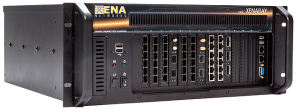 The XenaBay is a 12-slot chassis providing high port density and low power consumption. It supports up to 72 x 1 Gbps ports, 144 x 10 Gbps ports, 24 x 40 Gbps ports, or 6 x 100 Gbps ports in a 4U form factor.
The XenaBay is a 12-slot chassis providing high port density and low power consumption. It supports up to 72 x 1 Gbps ports, 144 x 10 Gbps ports, 24 x 40 Gbps ports, or 6 x 100 Gbps ports in a 4U form factor.

